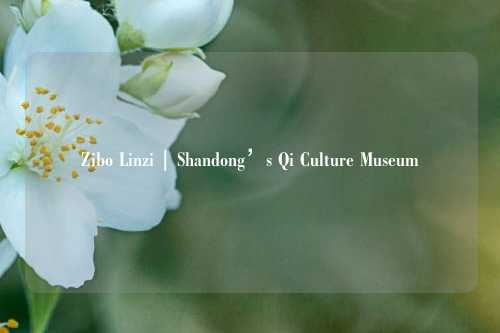Zibo Linzi | Shandong’s Qi Culture Museum
The city of Zibo, located in Shandong Province, is a place rich in historical significance, with a deep cultural heritage that extends thousands of years. Among its various attractions, one of the most captivating is the Qi Culture Museum, a site that draws attention to the illustrious history of the ancient Qi Kingdom. The museum serves as a dedicated space to explore and appreciate the legacy of Qi culture, providing visitors with a deeper understanding of a civilization that once flourished in the region.
The Origins of Qi Culture
Qi culture originates from the ancient Qi Kingdom, which existed in the eastern part of China during the Zhou Dynasty, from the 11th century BCE until 221 BCE. The kingdom played an important role in shaping the political, social, and cultural landscapes of ancient China. With its capital located near the modern-day city of Zibo, the Qi Kingdom was known for its strategic position along the central plains, as well as its significant influence in the region.

The Kingdom of Qi was one of the more prosperous states during the Spring and Autumn period, a time when various smaller kingdoms competed for power. Despite its eventual downfall, the legacy of Qi culture continued to thrive, leaving behind a wealth of artifacts, traditions, and knowledge. The city of Zibo today stands as a modern gateway to the past, where visitors can discover the stories and achievements of the Qi Kingdom that still resonate in Chinese history.
The Qi Culture Museum: A Place to Explore Ancient Traditions
The Qi Culture Museum is dedicated to preserving and showcasing the unique heritage of the Qi Kingdom. Established to promote the history of this ancient civilization, the museum is an essential stop for anyone interested in the cultural developments that took place in this region of China. The museum's exhibits are a carefully curated collection of artifacts, artwork, and relics that span the length of the Qi Kingdom’s existence, offering a glimpse into the lives of its people.
Architectural Design and Layout
The museum’s architecture is a blend of modern design and traditional Chinese elements, reflecting both the historical significance of the Qi Kingdom and its relevance in the present day. Upon entering the museum, visitors are greeted by an elegant space that accommodates the large collection of artifacts in an open, accessible environment. The building itself is a striking combination of glass and stone, creating an inviting atmosphere that encourages exploration and discovery.
The layout of the museum is designed to take visitors through different eras of the Qi Kingdom’s history. Starting with the early periods, the museum provides a detailed chronological journey that explores the development of Qi culture, including its art, philosophy, military prowess, and social structures. The exhibits are divided into thematic areas that cover everything from daily life in the Qi Kingdom to the achievements of its rulers, offering a comprehensive view of what life was like in this ancient civilization.
Artifacts and Exhibits
One of the key features of the Qi Culture Museum is its diverse collection of artifacts, each telling a different story of Qi culture. These artifacts include bronze vessels, jade ornaments, pottery, weaponry, and ancient tools. Each item is displayed with care, accompanied by detailed explanations that provide context and insight into its use in ancient Qi society. Many of these objects offer a glimpse into the technological advancements, craftsmanship, and artistic achievements of the Qi people.
The bronze vessels, for example, demonstrate the high level of metallurgy in ancient China. These beautifully crafted items, often used in religious and ceremonial contexts, showcase intricate designs and patterns that reflect the cultural and spiritual beliefs of the Qi Kingdom. The jade objects, equally significant, were often associated with nobility and the elite class, symbolizing power and prestige.
Another fascinating section of the museum is dedicated to the military history of the Qi Kingdom. The collection includes ancient weapons, armor, and tools used in warfare. These relics highlight the Qi Kingdom’s military strategy and their influence in shaping the balance of power in ancient China. The museum also delves into the important role of chariots in Qi warfare, with models and detailed representations of these battle vehicles on display.
In addition to physical artifacts, the museum also showcases historical records and documents that provide insight into the political and philosophical thinking of the time. These manuscripts reveal the governance systems of the Qi Kingdom and the ideas that influenced its rulers. Some of these writings also reflect the kingdom’s contributions to Confucian thought and other philosophical schools of the era.
The Influence of Qi Culture on Chinese History
The Qi Kingdom’s influence extended far beyond its geographical boundaries. It played a crucial role in the development of Chinese culture, particularly in the fields of governance, military strategy, and philosophy. The Qi rulers were known for their progressive approaches to administration, often embracing reform and innovation. The museum’s exhibits highlight how the state of Qi became a model for other kingdoms in terms of governance and military tactics.
One of the most significant aspects of Qi culture was its contribution to Confucianism. Confucius, one of China’s most revered philosophers, spent a period of his life in the Qi Kingdom, and many of his teachings were influenced by the ideas and practices he encountered there. The museum features exhibits that explain the relationship between Confucius and the Qi Kingdom, shedding light on how the region played a role in shaping his philosophies, which would later become fundamental to Chinese society.
Special Exhibitions and Cultural Programs
Throughout the year, the Qi Culture Museum hosts special exhibitions that focus on various aspects of Qi history and culture. These temporary exhibits often showcase newly discovered artifacts or provide deeper insights into particular areas of Qi civilization. Visitors can enjoy exhibits that explore the artistic achievements of Qi society, such as ceramics and bronze work, or learn about the famous figures who played a role in the kingdom’s history.
In addition to its regular exhibits, the museum offers cultural programs and activities designed to engage the public and promote understanding of Qi culture. These programs include workshops on traditional Chinese crafts, lectures on the history of the Qi Kingdom, and even reenactments of historical events. These interactive events provide visitors with a deeper connection to the culture and history on display, making the museum a dynamic center for cultural exchange.
The Museum’s Role in Preservation and Education
The Qi Culture Museum is not just a place for visitors to explore ancient artifacts; it also plays an important role in the preservation of Qi culture. The museum actively participates in archaeological excavations and research efforts aimed at uncovering new discoveries related to the Qi Kingdom. It collaborates with universities and research institutions to study artifacts and analyze historical texts, ensuring that Qi culture continues to be understood and appreciated by future generations.
The museum’s educational programs are also a key part of its mission. By offering guided tours, workshops, and lectures, the museum provides opportunities for students, scholars, and the general public to deepen their understanding of the Qi Kingdom and its impact on Chinese history. These programs help preserve the knowledge of this ancient civilization and share it with a global audience.
Visiting the Qi Culture Museum
The Qi Culture Museum is located in Zibo, which is easily accessible from major cities in Shandong Province. The museum is open to visitors year-round and offers both individual and group tours. The museum’s staff is knowledgeable and friendly, ensuring that visitors have an informative and enjoyable experience. For those interested in learning more about the Qi Kingdom, the museum provides detailed materials and resources that delve into various aspects of its culture and history.
When planning a visit, it is recommended to allocate a few hours to fully explore the museum's exhibits. The museum's layout is spacious, allowing visitors to take their time and appreciate the artifacts on display. Guided tours are available in multiple languages, making the museum accessible to international visitors. The museum is also equipped with modern amenities, including a gift shop where visitors can purchase books, souvenirs, and replicas of the artifacts on display.
Zibo itself offers other attractions that complement a visit to the Qi Culture Museum. The city is home to historical sites, traditional markets, and scenic parks, making it an excellent destination for those looking to experience both the ancient and modern aspects of Chinese life. A trip to Zibo provides a well-rounded experience that combines cultural exploration with relaxation and enjoyment.
The Qi Culture Museum stands as a proud reminder of the rich heritage of the Qi Kingdom and its lasting influence on Chinese civilization. Through its carefully curated exhibits, educational programs, and ongoing research, the museum continues to share the fascinating story of Qi culture with visitors from around the world. Whether you are a history enthusiast, a student of Chinese culture, or simply someone looking for an educational and enriching experience, the Qi Culture Museum offers a compelling glimpse into one of the most important chapters of ancient Chinese history.
















